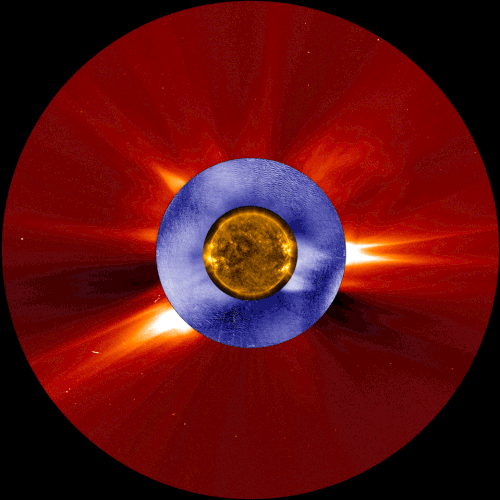Your gateway to endless inspiration
Stereo - Blog Posts

This composite image shows a coronal mass ejection, a type of space weather linked to solar energetic particles, as seen from two space-based solar observatories and one ground-based instrument. The image in gold is from NASA’s Solar Dynamics Observatory, the image in blue is from the Manua Loa Solar Observatory’s K-Cor coronagraph, and the image in red is from ESA and NASA’s Solar and Heliospheric Observatory.
Our constantly-changing sun sometimes erupts with bursts of light, solar material, or ultra-fast energized particles — collectively, these events contribute to space weather. A new study shows that the warning signs of one type of space weather event can be detected tens of minutes earlier than with current forecasting techniques – critical extra time that could help protect astronauts in space.
Credits: NASA/ESA/SOHO/SDO/Joy Ng and MLSO/K-Cor
Celebrating 10 Years of Revolutionary Solar Views
Twin spacecraft give humanity unprecedented views of the entire sun at one time, traveling to the far side of our home star over the course of a 10-year mission.

These two spacecraft are called STEREO, short for Solar and Terrestrial Relations Observatory. Launched on Oct. 25, 2006, and originally slated for a two-year mission, both spacecraft sent back data for nearly eight years, and STEREO-A still sends information and images from its point of view on the far side of the sun.

STEREO watches the sun from two completely new perspectives. It also provides information invaluable for understanding the sun and its impact on Earth, other worlds, and space itself – collectively known as space weather. On Earth, space weather can trigger things like the aurora and, in extreme cases, put a strain on power systems or damage high-flying satellites.
Because the rest of our sun-watching satellites orbit near our home planet, STEREO’s twin perspectives far from Earth give us a unique opportunity to look at solar events from all sides and understand them in three dimensions.

We use data from STEREO and other missions to understand the space environment throughout the solar system. This helps operators for missions in deep space prepare for the sudden bursts of particles and magnetic field that could pose a danger to their spacecraft.

STEREO has also helped us understand other objects in our solar system – like comets. Watching how a comet’s tail moves gives us clues about the constant stream of particles that flows out from the sun, called the solar wind.

STEREO is an essential piece of our heliophysics fleet, which includes 17 other missions. Together, these spacecraft shed new light on the sun and its interaction with space, Earth, and other worlds throughout the solar system.
To celebrate, we’re hosting a Facebook Live event on Wednesday, Oct. 26. Join us at noon ET on the NASA Sun Science Facebook page to learn more about STEREO and ask questions.
Learn more about how NASA studies the sun at: www.nasa.gov/stereo
Follow us on Tumblr for your regular dose of space: http://nasa.tumblr.com